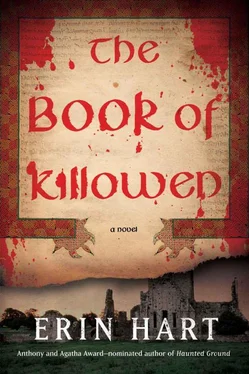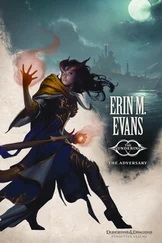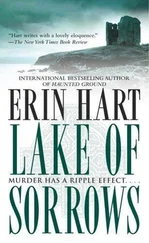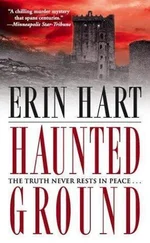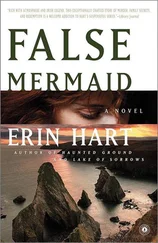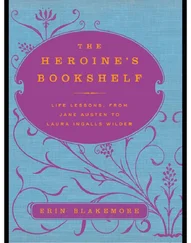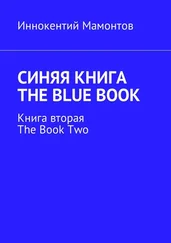Molloy placed the attaché case on the table and flipped it open, perusing the papers inside. “Looks like notes for a book or a paper about marginalia—”
“Why does that sound a bit unsavory?”
Molloy smiled. “It’s just the little notes that monks used to write at the edges of their manuscripts. Some wrote poems, or scribbled down random thoughts they had while copying.”
Stella was pleased to see that Molloy’s secondment to the Antiquities Task Force last year was paying off. But she was thinking about Benedict Kavanagh, not about monks. “So this trip may have had more to do with his work than with his wife?”
“Seems that way, so far at least. There’s nothing at all about her and quite a lot about old manuscripts. He seems to have made a translation of a poem in Irish. Here, read this.” He offered her a handwritten page, alive with scribbled notes and underlines.
“This Kavanagh’s handwriting?” she asked.
“Looks to be.”
Stella turned the page sideways, following several lines of text that seemed written with particular force:
A little hut in the wood, none knows it but myself.
A lowly, hidden hut, among the paths of the forest,
Will you return with me to see where it lies?
The stags of Feadán Mór leap from its streams amid sweet meadows.
From my hut great Arderin can be seen to the east.
A clutch of eggs, sweet apples, heath peas, and honey;
haws, yew berries, nuts from the branching green hazels.
After the poem came a cryptic code in Kavanagh’s hand: “i, 1!!!!?”
“Any idea what this means—i-one?”
Molloy shrugged. “No, but the poem sounds like something a monk would have scribbled at the edge of his manuscript. We read a few of these, studying Old Irish at school.”
Stella remembered that Molloy had been educated at a gaelscoil , where everything was taught through Irish language—maths, physics, geography, the lot. And at that moment, the distance between the two of them seemed incrementally wider. They might as well have come up in different centuries, for all they had in common.
“What’s this?” Stella pointed to another notation, where Kavanagh had written “An Feadán Mór, 8k sw Birr, off N52.” She paused for a moment, thinking back to something Mairéad Broome had said in Dublin, about the breakthrough her husband had just made in his work. This is going to rattle some bones , he’d said. Two bodies in the boot of a car was a rattling of actual bones. There was something right under the surface here, she could feel it.
“Fergal, do you think Kavanagh could have been mixed up with treasure hunters?”
“Not out of the question, I suppose. They try to get all sorts of people in those smuggling rings—museum staffers, even coppers.” Molloy grinned. “They know we’re always skint.”
“But Kavanagh wasn’t. He’d plenty of money, according to the wife.”
“Ah, but some of them aren’t in it for the money,” Molloy said. “For them it’s all about getting your hands on something very old and rare. And book people are especially fanatical—or so I hear.”
Stella took a marker and started writing on the time line. “So, from the landlady we know Kavanagh arrived at the B and B in Crinkill on the evening of Thursday, April twenty-first, where he stayed for at least two nights, and went off between Saturday the twenty-third and the morning of Sunday April twenty-fourth and never returned.”
“Let’s put the wife’s time line up next to his,” Molloy said, grabbing a blue marker. “She and Graham Healy drive down to Cork for the exhibition installation on April fourteenth; they supposedly arrive at the friend’s house in Mountrath on April twenty-first and stay for a week, then head home to Dublin on the twenty-eighth. She waits around three days before reporting the husband missing on the first of May.”
Stella added a red line. “Work on the geothermal system at Killowen commences on April twentieth, and wraps up on the thirtieth. Niall Dawson is there for a couple of days around April twenty-second.” She paused, thinking of the way Kavanagh’s body had been left—tongue cleaved down the middle, gallnuts blocking his airway. There was a message in all that, but what was it? “What does a split tongue say to you, Fergal?”
“Signifies a liar, doesn’t it, someone who can’t tell the truth?”
“The serpent in the garden,” Stella murmured. “Let’s fire up that laptop.”
Molloy was keen on computers of all kinds and had no trouble navigating his way through the laptop to find out which files Kavanagh had accessed most recently.
“Seems like he’s downloaded quite a few images,” Molloy said, squinting at the monitor. He looked up at her. “Internet porn—what’ll you wager?”
“I’m not betting on anything. Let’s have a look.”
Molloy pushed a button, and dozens of files opened on the screen.
“Hah! Well, they’re skin pictures, right enough,” he said, “just not the sort of skin you’d expect.” Rather than rosy human flesh, the images were close-ups of parchment pages, Latin words inscribed in translucent brown ink. “Old manuscripts,” Molloy said. “Book of Kells old.”
“They were Kavanagh’s thing,” Stella said. “Isn’t that what everyone’s been telling us?”
“It’s the same poem as he’s translated.” Molloy was staring at the image on the screen. “Amazing.”
“What’s amazing?”
“Well, think of it: there used to be whole libraries full of books like this, copied out by hand. Jesus, all the time and effort those poor buggers the monks put into each one. We take it for granted now, don’t we—the printing press, the copy machine, the Internet. I mean, words lose their value, in a way, don’t they, when you’re drowning in them?”
“Never thought of it that way, but I suppose you’re right.”
She returned to the briefcase, finding numerous modern handwritten pages in the same distinctive rounded hand as the notes. They were beautiful to look at, although the words were mostly incomprehensible, the kind of scholarly language that made her eyes glaze over. She turned the page around to read tiny shorthand notes in the margin:
Extant mss:
1) Reims, B municip, 875, ff. 1 r–358 v; s. ix 2(apart from ff. 212–7, c. AD 1000); numerous additions and corrections in Irish hands, i 1and i 2; origin perhaps Saint-Médard de Soissons; provenance Reims.
2) St Gall, Stiftsb, 274, p. 4; s. ix [fragment of book 1].
3) Laon, B municip, 444; s. ix 2(AD 870–875); origin Laon.
4) Feadán Mór?
There was a gap below the last entry and then a hastily scribbled note:
IOH returns to IRL, great work unfinished—Malmesbury mentions An Feadán Mór, revised ed Gesta Pontificum Anglorum (ff. 153–200v).
Stella frowned. “I don’t know what any of this has got to do with Kavanagh’s wife being here at the artists’ retreat. But I don’t think we’re on the wrong track with her. I’m going out there to have another chat. In the meantime, Fergal, why don’t you get on the phone and see if you can do some checking into Graham Healy’s background.”
“Looking for…?”
“Any experience with heavy machinery. Somebody dug that hole in the bog.”
“Art school type,” Molloy scoffed. “Doubtful if he’s ever got his hands dirty.”
“You never know,” Stella said, remembering the construction materials piled in Mairéad Broome’s house. “Sometimes art can be more industrial than people imagine.” Stella looked back at Kavanagh’s notes. “While you’re at it, Fergal, why don’t you also put in a call to your pals on the Antiquities Task Force? And what about Interpol—they investigate art forgery and book theft, right? Give them the names of the players in our little drama, see if any of them have form in that area. You said Martin Gwynne was suspected of nicking something from the British Library. Let’s see if there’s anything else in his record.”
Читать дальше
